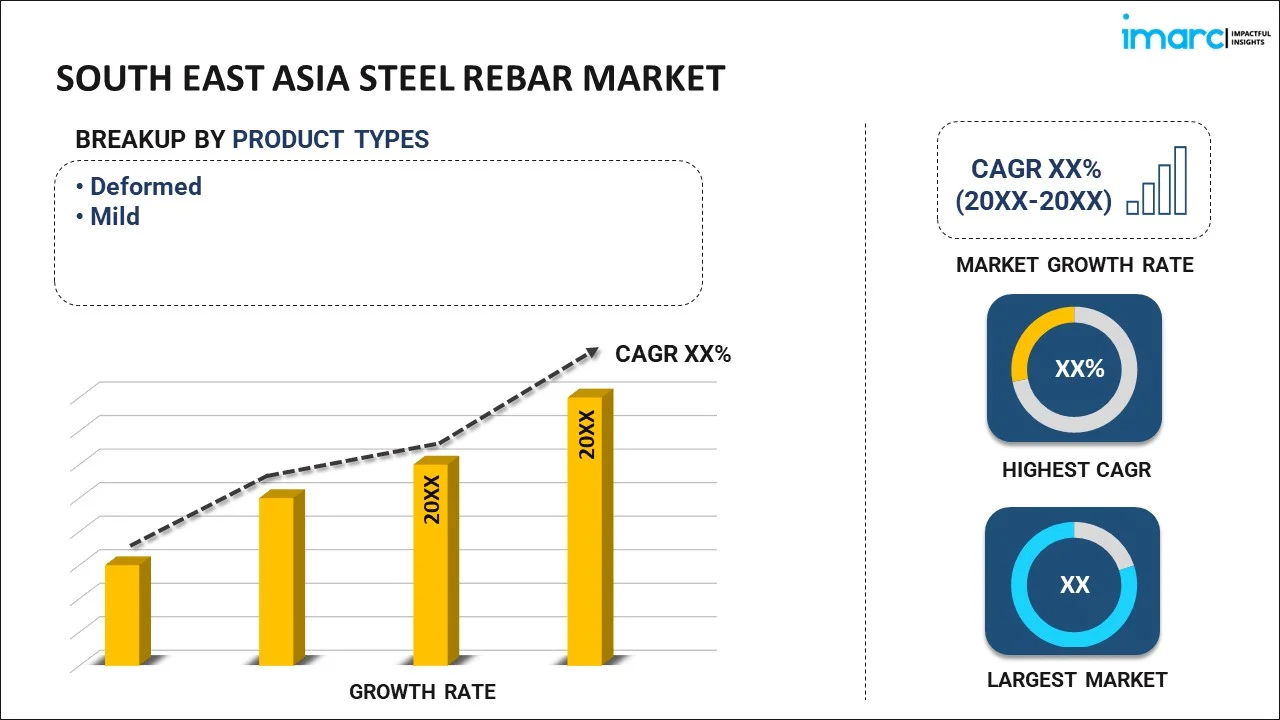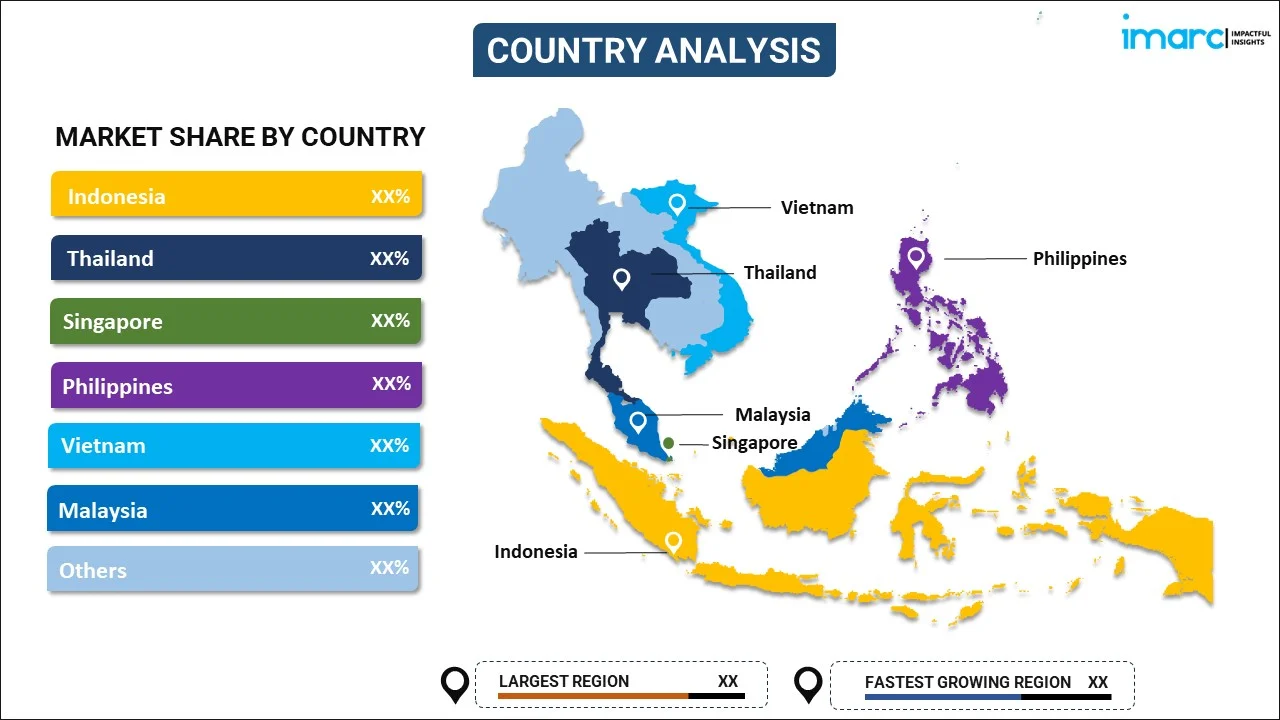
South East Asia Steel Rebar Market Report by Product Type (Deformed, Mild), Process (Basic Oxygen Steelmaking, Electric Arc Furnace), Finishing Type (Epoxy, Coated, Black), End Use (Residential, Commercial, Industrial), and Country 2024-2032
Market Overview:
South East Asia steel rebar market size is projected to exhibit a growth rate (CAGR) of 6.04% during 2024-2032. The increasing urbanization, which often requires the construction of new buildings and infrastructure, creating a sustained demand for steel rebar is driving the market.
|
Report Attribute
|
Key Statistics
|
|---|---|
|
Base Year
|
2023 |
|
Forecast Years
|
2024-2032
|
|
Historical Years
|
2018-2023
|
| Market Growth Rate (2024-2032) | 6.04% |
Steel rebar, short for reinforcing bars, is a crucial construction material extensively used to enhance the tensile strength of concrete structures. Comprising high-strength steel, rebar is strategically embedded within concrete before it solidifies, creating a composite material that can withstand a variety of stresses, including tension and compression. Its primary function is to reinforce and fortify concrete, mitigating the risk of structural failure due to forces such as earthquakes, heavy loads, or temperature fluctuations. The distinctive ribbed surface of steel rebar ensures a strong bond with the surrounding concrete, preventing slippage and enhancing overall structural stability. Rebar comes in various sizes and shapes, tailored to specific construction requirements. Its widespread use in the construction industry underscores its importance in ensuring the durability and longevity of buildings, bridges, and other infrastructure projects. The application of steel rebar exemplifies a synergy between materials, combining the compressive strength of concrete with the tensile strength of steel to create resilient structures.
South East Asia Steel Rebar Market Trends:
The steel rebar market in South East Asia is experiencing robust growth, driven by several key factors that are intricately interconnected. Firstly, the burgeoning regional construction industry serves as a primary catalyst, propelling the demand for steel rebar as a fundamental component in reinforced concrete structures. Additionally, rapid urbanization further accentuates this demand, with expanding infrastructural projects necessitating substantial quantities of steel reinforcement. Moreover, the emphasis on sustainable construction practices acts as a pivotal driver for the steel rebar market. As environmental concerns escalate, stakeholders increasingly recognize the benefits of steel rebar in enhancing the durability and longevity of structures, aligning with the principles of green building. This has spurred a shift towards steel reinforcement, which not only enhances structural integrity but also minimizes the environmental impact compared to alternative materials. Furthermore, government initiatives and investments in infrastructure development contribute significantly to the market's momentum. The interconnected nature of these drivers underscores the dynamic forces propelling the steel rebar market in South East Asia, positioning it as a pivotal player in the construction and infrastructure landscape.
South East Asia Steel Rebar Market Segmentation:
IMARC Group provides an analysis of the key trends in each segment of the market, along with forecasts at the regional and country levels for 2024-2032. Our report has categorized the market based on product type, process, finishing type, and end use.
Product Type Insights:

- Deformed
- Mild
The report has provided a detailed breakup and analysis of the market based on the product type. This includes deformed and mild.
Process Insights:
- Basic Oxygen Steelmaking
- Electric Arc Furnace
A detailed breakup and analysis of the market based on the process have also been provided in the report. This includes basic oxygen steelmaking and electric arc furnace.
Finishing Type Insights:
- Epoxy
- Coated
- Black
The report has provided a detailed breakup and analysis of the market based on the finishing type. This includes epoxy, coated, and black.
End Use Insights:
- Residential
- Commercial
- Industrial
A detailed breakup and analysis of the market based on the end use have also been provided in the report. This includes residential, commercial, and industrial.
Country Insights:

- Indonesia
- Thailand
- Singapore
- Philippines
- Vietnam
- Malaysia
- Others
The report has also provided a comprehensive analysis of all the major regional markets, which include Indonesia, Thailand, Singapore, Philippines, Vietnam, Malaysia, and Others.
Competitive Landscape:
The market research report has also provided a comprehensive analysis of the competitive landscape. Competitive analysis such as market structure, key player positioning, top winning strategies, competitive dashboard, and company evaluation quadrant has been covered in the report. Also, detailed profiles of all major companies have been provided. Some of the key players include:
- Alliance Steel (M) Sdn. Bhd.
- Hoa Phat Group
- PT. Ispat Indo
- Tata Steel Ltd (Tata Group)
(Please note that this is only a partial list of the key players, and the complete list is provided in the report.)
South East Asia Steel Rebar Market Report Coverage:
| Report Features | Details |
|---|---|
| Base Year of the Analysis | 2023 |
| Historical Period | 2018-2023 |
| Forecast Period | 2024-2032 |
| Units | US$ Million |
| Scope of the Report | Exploration of Historical and Forecast Trends, Industry Catalysts and Challenges, Segment-Wise Historical and Predictive Market Assessment:
|
| Product Types Covered | Deformed, Mild |
| Processes Covered | Basic Oxygen Steelmaking, Electric Arc Furnace |
| Finishing Types Covered | Epoxy, Coated, Black |
| End Uses Covered | Residential, Commercial, Industrial |
| Countries Covered | Indonesia, Thailand, Singapore, Philippines, Vietnam, Malaysia, Others |
| Companies Covered | Alliance Steel (M) Sdn. Bhd., Hoa Phat Group, PT. Ispat Indo, Tata Steel Ltd (Tata Group), etc. (Please note that this is only a partial list of the key players, and the complete list is provided in the report.) |
| Customization Scope | 10% Free Customization |
| Report Price and Purchase Option | Single User License: US$ 3699 Five User License: US$ 4699 Corporate License: US$ 5699 |
| Post-Sale Analyst Support | 10-12 Weeks |
| Delivery Format | PDF and Excel through Email (We can also provide the editable version of the report in PPT/Word format on special request) |
Key Questions Answered in This Report:
- How has the South East Asia steel rebar market performed so far and how will it perform in the coming years?
- What has been the impact of COVID-19 on the South East Asia steel rebar market?
- What is the breakup of the South East Asia steel rebar market on the basis of product type?
- What is the breakup of the South East Asia steel rebar market on the basis of process?
- What is the breakup of the South East Asia steel rebar market on the basis of finishing type?
- What is the breakup of the South East Asia steel rebar market on the basis of end use?
- What are the various stages in the value chain of the South East Asia steel rebar market?
- What are the key driving factors and challenges in the South East Asia steel rebar?
- What is the structure of the South East Asia steel rebar market and who are the key players?
- What is the degree of competition in the South East Asia steel rebar market?
Key Benefits for Stakeholders:
- IMARC’s industry report offers a comprehensive quantitative analysis of various market segments, historical and current market trends, market forecasts, and dynamics of the South East Asia steel rebar market from 2018-2032.
- The research report provides the latest information on the market drivers, challenges, and opportunities in the South East Asia steel rebar market.
- Porter's five forces analysis assist stakeholders in assessing the impact of new entrants, competitive rivalry, supplier power, buyer power, and the threat of substitution. It helps stakeholders to analyze the level of competition within the South East Asia steel rebar industry and its attractiveness.
- Competitive landscape allows stakeholders to understand their competitive environment and provides an insight into the current positions of key players in the market.
Need more help?
- Speak to our experienced analysts for insights on the current market scenarios.
- Include additional segments and countries to customize the report as per your requirement.
- Gain an unparalleled competitive advantage in your domain by understanding how to utilize the report and positively impacting your operations and revenue.
- For further assistance, please connect with our analysts.
 Inquire Before Buying
Inquire Before Buying
 Speak to an Analyst
Speak to an Analyst
 Request Brochure
Request Brochure
 Request Customization
Request Customization




.webp)




.webp)












